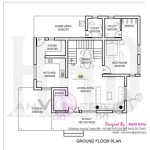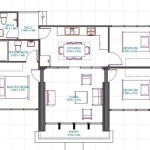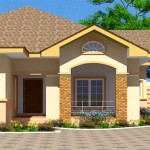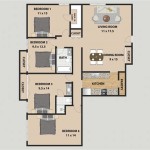Spanish Colonial Bungalow House Plans: A Timeless Architectural Style
Spanish Colonial Bungalow house plans offer a unique blend of European elegance and American practicality. This architectural style, popularized in the early 20th century, particularly in the Southwestern United States and Florida, continues to resonate with homeowners seeking a home rich in history and charm. The style draws inspiration from the Spanish Colonial architecture prevalent in Spain's former colonies, incorporating elements that reflect the region's climate and culture.
Key characteristics of Spanish Colonial Bungalow house plans include low-pitched red tile roofs, white stucco walls, and arched doorways and windows. These features contribute to the style's distinctive Mediterranean appearance. The red tile roofs, besides their aesthetic appeal, provide excellent insulation against the heat, while the white stucco walls reflect sunlight, keeping the interiors cool. Arches, a hallmark of Spanish architecture, add a touch of grandeur and visual interest to the facade.
Floor plans for Spanish Colonial Bungalows typically emphasize a connection between indoor and outdoor living spaces. Courtyards, patios, and verandas are common features, often seamlessly integrated into the home's design. These outdoor spaces provide areas for relaxation and entertainment, blurring the lines between the indoors and outdoors, a characteristic highly valued in warmer climates.
Interior layouts often feature a central living area with surrounding bedrooms. This arrangement promotes a sense of community and facilitates easy interaction among family members. Fireplaces, frequently found in the living room, add warmth and serve as a focal point. Beamed ceilings, often made of wood, add architectural detail and enhance the sense of spaciousness.
Decorative elements play a significant role in Spanish Colonial Bungalow design. Ornate ironwork, often seen in window grilles, railings, and light fixtures, adds a touch of artistry and elegance. Tilework, used for flooring, backsplashes, and decorative accents, introduces vibrant colors and patterns inspired by traditional Spanish designs. Niches, built into the walls, provide display areas for artwork and other decorative objects.
Variations within the Spanish Colonial Bungalow style exist, reflecting regional influences and individual preferences. Some designs incorporate more elaborate ornamentation, while others maintain a simpler, more streamlined aesthetic. The size and layout of the homes also vary, ranging from modest one-story bungalows to larger two-story residences.
Modern adaptations of Spanish Colonial Bungalow house plans often incorporate contemporary amenities while retaining the style's essential characteristics. Updated kitchens and bathrooms, open floor plans, and energy-efficient features can be seamlessly integrated into the traditional design. This allows homeowners to enjoy the charm of a historic style while benefiting from modern conveniences.
Choosing a house plan involves careful consideration of various factors, including lifestyle, budget, and lot size. The availability of suitable building materials and the expertise of local contractors also play a role in the decision-making process. Consulting with an architect or a qualified building professional is recommended to ensure that the chosen plan meets specific needs and complies with local building codes.
The enduring appeal of Spanish Colonial Bungalow house plans stems from their timeless elegance and adaptability. The style's inherent connection to nature, emphasis on outdoor living, and use of natural materials create a welcoming and comfortable environment. These factors, combined with the style's rich history and cultural significance, make Spanish Colonial Bungalow homes a desirable choice for those seeking a unique and enduring architectural style.
Finding the right Spanish Colonial Bungalow house plan involves researching various architectural resources, both online and offline. Architectural magazines, books, and websites offer a wealth of information and inspiration. Many architectural firms specialize in this style and can provide custom designs or adapt existing plans to meet individual needs. Working closely with an architect ensures that the final plan reflects personal preferences and site-specific considerations.
Landscaping plays a crucial role in enhancing the beauty and functionality of a Spanish Colonial Bungalow. Drought-tolerant plants, such as cacti, succulents, and native grasses, complement the style's arid origins and require minimal maintenance. Courtyard gardens, featuring fountains and colorful flowers, create a serene and inviting outdoor space. Paths made of stone or brick add visual interest and provide access to different areas of the landscape.
The use of authentic materials enhances the authenticity of a Spanish Colonial Bungalow. Clay roof tiles, stucco walls, and wood beams contribute to the style's distinctive character. Selecting high-quality materials ensures durability and longevity, while also adding value to the property. Proper maintenance and regular upkeep are essential to preserve the beauty and integrity of these materials over time.

Bungalow House Plans Spanish Style Homes Craftsman

Bungalow House Plans Colonial Mediterranean

Spanish Style Plans 1900 To1935 Vintage House Homes

1928 Home Builders Catalog Bungalow House Plans Spanish

1927 Radford Zamora Spanish Eclectic Style Small House Design Inspiration Vintage American Architure

Small Spanish Contemporary House Plan 61custom Modern Plans

1930 Practical Homes House Plans Bungalow Design With Pictures

Verago A Modern Mediterranean House Plan Sater Design Collection

Bungalow House Plans Plan Service Co Late Twenties Daily Flickr Vintage Floor

1925 Eclectic Spanish Style Cottage Pacific Ready Cut Homes No 387








